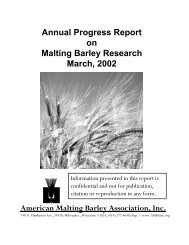Annual Progress Report on Malting Barley Research March, 2007
Annual Progress Report on Malting Barley Research March, 2007
Annual Progress Report on Malting Barley Research March, 2007
You also want an ePaper? Increase the reach of your titles
YUMPU automatically turns print PDFs into web optimized ePapers that Google loves.
MISSION: The primary purpose of AMBA is to encourage and support an adequate<br />
supply of high quality malting barley for the malting and brewing industry and increase<br />
our understanding of malting barley.<br />
PRIMARY OBJECTIVE: Develop malting barley varieties with improved agr<strong>on</strong>omic and<br />
quality characters to keep malting barley competitive with other crops so that growers<br />
c<strong>on</strong>tinue to plant and produce an adequate supply of suitable quality for improved<br />
utilizati<strong>on</strong> by the industry.<br />
OBJECTIVES, METHODOLOGY AND RESULTS –<br />
AMBA FUNDED PROJECT(S)<br />
1.) Early Generati<strong>on</strong> Quality Testing Program and Cooperative Malt Quality<br />
<strong>Research</strong>. Approximately 3350 early generati<strong>on</strong> lines and cultivars (NDSU <strong>Malting</strong><br />
<strong>Barley</strong> Variety Development Program), grown in 2006, were submitted for preliminary<br />
screening. This was up by approximately 160 samples from 2005. These samples were<br />
screened by near infrared reflectance (NIR) for protein and color. Kernel assortment<br />
and test weight were additi<strong>on</strong>ally determined <strong>on</strong> 3200 of the samples, which is an<br />
increase of approximately 1000 from 2005. Lines and varieties (130) from the 2006<br />
NDSU variety plot trials were micro-malted and analyzed for standard quality<br />
parameters.<br />
Micro-malting and malt quality testing services are provided to research cooperators.<br />
This work supports research. These samples are not part of the normal barley varietal<br />
development program.<br />
• 181 barley samples were malted analyzed for Dr Lynn Dahleen and Dr Phil<br />
Bregitzer. These samples were for a study <strong>on</strong> the expressi<strong>on</strong> of anti-fungal<br />
genes in barley, and their impact <strong>on</strong> both Fusarium Head Blight resistance and<br />
malt quality.<br />
• 98 samples were malted and analyzed for Dr Rich Horsley, as part of study <strong>on</strong><br />
the adaptati<strong>on</strong> of European lines and cultivars in North Dakota and M<strong>on</strong>tana.<br />
2.) Applied Malt Quality <strong>Research</strong>. Much of the current methodology used in malt<br />
analysis was developed from the late 19 th to mid 20 th century. Changing technology as<br />
well increased analytical demands and expectati<strong>on</strong>s have identified some methods as<br />
problematic. As example, we recently reassessed methodology for C<strong>on</strong>gress mashing<br />
(Schwarz et al <strong>2007</strong>). The current project, which was directly funded by AMBA in 2006<br />
involves the determinati<strong>on</strong> of alpha-amylase in malt.<br />
Measurement of Malt Alpha-Amylase. The determinati<strong>on</strong> of alpha-amylase in malt by<br />
automated flow analysis has been challenging since its introducti<strong>on</strong> in the 1970’s.<br />
76
















